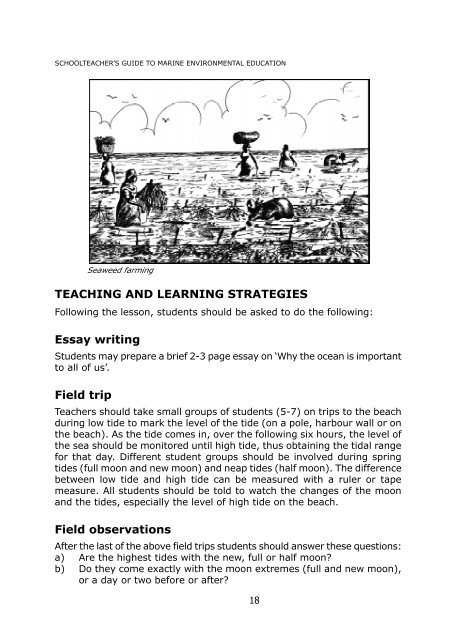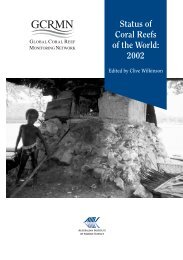A School Teachers Guidebook to Marine Environmental Education ...
A School Teachers Guidebook to Marine Environmental Education ...
A School Teachers Guidebook to Marine Environmental Education ...
Create successful ePaper yourself
Turn your PDF publications into a flip-book with our unique Google optimized e-Paper software.
SCHOOLTEACHER’S GUIDE TO MARINE ENVIRONMENTAL EDUCATION<br />
Seaweed farming<br />
TEACHING AND LEARNING STRATEGIES<br />
Following the lesson, students should be asked <strong>to</strong> do the following:<br />
Essay writing<br />
Students may prepare a brief 2-3 page essay on ‘Why the ocean is important<br />
<strong>to</strong> all of us’.<br />
Field trip<br />
<strong>Teachers</strong> should take small groups of students (5-7) on trips <strong>to</strong> the beach<br />
during low tide <strong>to</strong> mark the level of the tide (on a pole, harbour wall or on<br />
the beach). As the tide comes in, over the following six hours, the level of<br />
the sea should be moni<strong>to</strong>red until high tide, thus obtaining the tidal range<br />
for that day. Different student groups should be involved during spring<br />
tides (full moon and new moon) and neap tides (half moon). The difference<br />
between low tide and high tide can be measured with a ruler or tape<br />
measure. All students should be <strong>to</strong>ld <strong>to</strong> watch the changes of the moon<br />
and the tides, especially the level of high tide on the beach.<br />
Field observations<br />
After the last of the above field trips students should answer these questions:<br />
a) Are the highest tides with the new, full or half moon?<br />
b) Do they come exactly with the moon extremes (full and new moon),<br />
or a day or two before or after?<br />
18
















